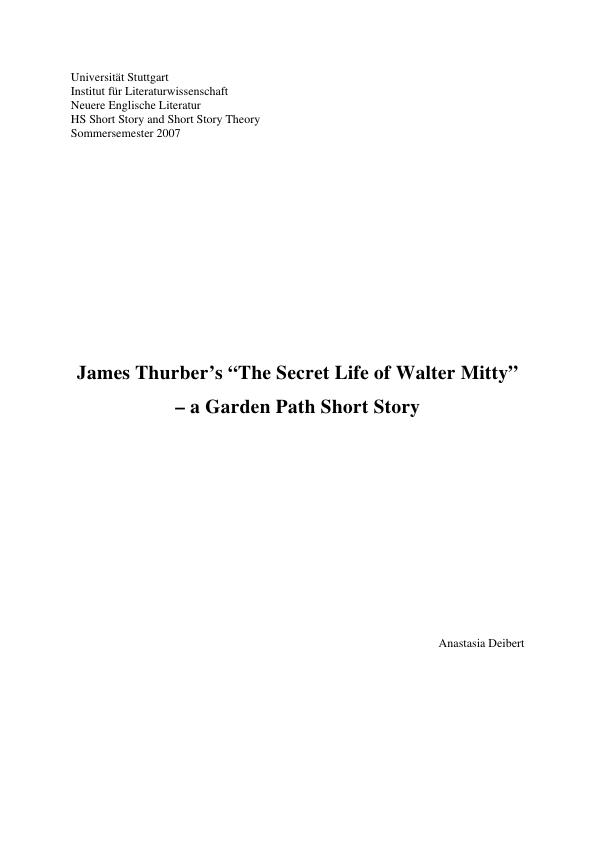In the following pages I want to focus on James Thurber’s famous short story “The Secret Life of Walter Mitty” which was first published in 1939 in the magazine The New Yorker. Thurber tells the story of a Walter Mitty, a man who lives in a dream world to escape from the routines and humiliations which he suffers in everyday life.
Today the name “Walter Mitty” also exists in the English language and is used for people who are daydreaming and not paying attention to the real world. Walter Mitty became an archetypal American figure.
By reason of the structure of the short story and “Thurber’s own narrative style – economical, lightly ironic, and wonderfully expressive” (Holmes 218) it seems that this short story can be seen as a garden path story. The expression “to lead someone up the garden path” means “to deliberately deceive someone”. Manfred Jahn analysed this short story with respect to his garden path short story theory. Can “The Secret Life of Walter Mitty” generally be regarded as a garden path story? What is of particular interest is whether the reader is misled by Thurber’s narrative technique especially at the beginning of the story. What are the reasons for Walter Mitty’s escapist daydreams and how is Mitty’s character presented in the story?
Firstly, I will describe the garden path phenomenon and applied to “The Secret Life of Walter Mitty” I will analyse the beginning of the short story. In addition, I will name some hints where the reader realises Walter Mitty’s various daydream episodes. In the next chapter I will concentrate on the story’s two narrative levels. First of all, I will describe Mitty’s development in the course of his daydreams and then I will take a look on the real Walter Mitty. Moreover, I will briefly try to find similarities between James Thurber and Walter Mitty. Afterwards, James Thurber’s narrative style and his sense of humour will be presented. The conclusion will comprise the main points and some suggestions for further discussion.
Table of Contents
- Introduction
- The Garden Path Phenomenon
- A Garden Path Beginning
- Indications for Fantasy Scenes
- Real world vs. Daydreams
- Development in Mitty's Daydreams
- The Henpecked Walter Mitty
- Thurber - Parallels to Mitty
- Thurber's Narrative Style
- Seriousness of Thurber's Humour
- Conclusion
Objectives and Key Themes
This paper focuses on James Thurber's short story "The Secret Life of Walter Mitty," analyzing its structure and narrative techniques in light of Manfred Jahn's garden path theory. The paper aims to explore the relationship between Walter Mitty's real life and his daydreams, and to understand how Thurber's narrative style creates a sense of ambiguity that leads the reader down a "garden path."
- The garden path phenomenon and its application to "The Secret Life of Walter Mitty"
- The contrasting worlds of Walter Mitty's reality and his daydreams
- Thurber's narrative style and its role in creating ambiguity and humor
- The significance of Walter Mitty's character as an archetypal figure
- The use of language and over-dramatization in Mitty's daydreams
Chapter Summaries
The introduction provides an overview of the short story and its significance, establishing the focus on the garden path phenomenon and Walter Mitty's daydreams.
Chapter 2 examines the garden path phenomenon in relation to literature, defining its key characteristics and exploring its application to "The Secret Life of Walter Mitty." The chapter analyzes how Thurber's narrative technique, particularly at the beginning of the story, misleads the reader.
Chapter 3 delves into the contrasting worlds of Walter Mitty's reality and his daydreams. It explores how Mitty's daydreams develop over time and examines his character in both his real life and his fantasy world. The chapter also discusses potential parallels between Thurber and Walter Mitty.
Chapter 4 examines Thurber's narrative style, highlighting its economic and ironic nature, and its contribution to the overall effectiveness of the story.
Chapter 5 focuses on the nature of Thurber's humor, considering its serious undertones and exploring how it contributes to the deeper meaning of the story.
The conclusion, which is excluded from this preview, will summarize the main points of the analysis and offer suggestions for further discussion.
Keywords
The key concepts explored in this paper include: garden path phenomenon, short story theory, narrative structure, ambiguity, daydreams, escapism, characterization, narrative style, humor, Walter Mitty, James Thurber, and archetypal figure. The paper also draws upon the ideas of Manfred Jahn, a prominent scholar in the field of garden path theory.
- Citation du texte
- Anastasia Deibert (Auteur), 2007, James Thurber’s “The Secret Life of Walter Mitty” , Munich, GRIN Verlag, https://www.grin.com/document/85711




